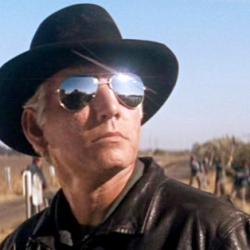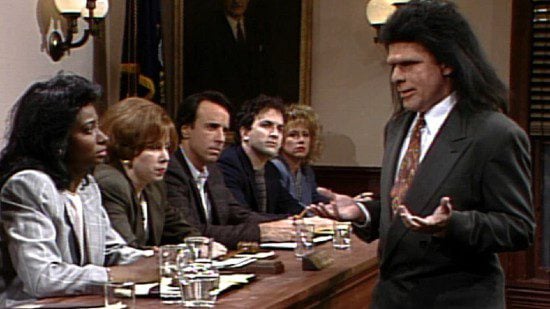The screenshot below is from a fourth-season episode of Bones that originally aired in October of 2008. But the disappointment that led me to grab this picture isn’t only directed at the directors and writers and editors of that rom-com murder procedural.

In the scene, this is a murder suspect’s Bible, resting on the table in an FBI interrogation room. Before we get into what’s wrong with this scene, let’s first note the many things it got right. The suspect here is the son of a crooked televangelist. He’s seems based on Jay Bakker, son of Jim and Tammy Faye, and they get the wardrobe here so spot-on I’d almost guess they borrowed Jay’s clothes for the scene. And up to a point, they get the character’s Bible right too, with the brown-paper dust jacket held together with duct tape and covered in graffiti.
It’s the content of that biblical graffiti that misses the mark so badly here. The largest Bible reference is John 5:1. That’s what made me hit pause and then look closer here, because I was thinking “What the heck is John 5:1?” So I opened a new tab to look it up: “After this there was a festival of the Jews, and Jesus went up to Jerusalem.”
That’s stage directions — a scene change.* It’s not really a bumper-sticker verse, or one that white evangelical kids would use as their yearbook quote or claim as their “life verse.” I very much was the kind of evangelical kid who used to write Bible references on brown-paper dust jackets, but this was very much not the kind of verse any of us would have written there.
It’s the wrong verse for this character and for this scene. It doesn’t serve the character, or the story, plot, or theme. “John 5:1” doesn’t belong here. That’s especially frustrating because the story it introduces — Jesus healing on the Sabbath — actually does resonate with this character and the plot and theme of this episode. Mark’s version of that story works better than John’s here, so if I’d been directing this scene, I’d have that reference read “Mark 2:27.”
The other Bible references scrawled here don’t make much sense either. Proverbs 30:30 is part of a three-verse triad and doesn’t stand alone. It seems included here just as a bit of biblical lorem ipsum. Why did they choose that verse? Apparently only because they didn’t think anyone would pause the screen long enough to be able to read it.
And then there’s the reference to Ezekiel. Ah, of course, you think, seeing that — Ezekiel, on Bones, yes. But then you look again and realize that “Ezek. 11” — whatever that is — is not Ezekiel 37, which is just sitting right there and they just missed it:
The Spirit of the Lord set me in the middle of a valley; it was full of bones. He led me back and forth among them, and I saw a great many bones on the floor of the valley, bones that were very dry. He asked me, “Son of man, can these bones live?”
I said, “Sovereign Lord, you alone know.”
Then he said to me, “Prophesy to these bones and say to them, ‘Dry bones, hear the word of the Lord! This is what the Sovereign Lord says to these bones: I will make breath enter you, and you will come to life. I will attach tendons to you and make flesh come upon you and cover you with skin; I will put breath in you, and you will come to life. Then you will know that I am the Lord.’”
This particular episode of Bones was about rebirth, redemption, and physical transformation, so this would have been a resonant passage, reinforcing the character and story arc of both the murder victim and her son.**
But apart from the theme and characters of this one episode, this is a show called “Bones.” The main, title character is a genius forensic anthropologist who finds it easier to relate to a valley of dry bones than a room full of living people. Those verses in Ezekiel 37, in a way, describe her own calling. Even though “Bones,” herself, is a rationalist, empiricist who is dismissively skeptical of all religion, it would not be out of character for her to be able to recite this particular passage from memory.
“Ezekiel 37” should have been written on that prop Bible. Heck, it should have been written out on a poster hanging in the writer’s room for this show.
Noah Hawley was the story editor and one of the main writers on that season of Bones. I wouldn’t have guessed, back in 2008, that the guy helping to crank out this show would go on to create anything as ambitious and dazzling as Fargo and Legion. The latter, in particular, seems to trace its lineage not just to its comic-book source material, but to earlier generations of acclaimed TV series involving unreliable narrators who do not, themselves, trust what they’re seeing. I’m 99% sure that before creating Legion, Hawley watched and studied both The Prisoner and The Singing Detective.
Both of those classic series regularly make critics’ lists of the greatest TV shows of all time. Another thing they both have in common, strangely, is that both feature beautifully surreal musical interludes involving James Weldon Johnson’s Ezekiel 37-based spiritual “Dem Bones.” Here’s the Singing Detective (and, yes, that’s Imelda Staunton playing skulls like a xylophone):
And here’s the scene from The Prisoner:
My point here is not that I wanted to see the walls of the FBI interrogation room fall away, fading into a full-on Busby Berkeley production of “Dem Bones.” I’m just saying that the folks involved in this scene really ought to have had some awareness of that song and the biblical passage that inspired it. And given that, when seeking an apt biblical reference to scrawl on the prop Bible in this scene, they ought to have used Ezekiel 37 rather than just filling in the space with irrelevancies like “John 5:1” and “Ezek. 11.” (The show partially atones for this, several seasons later, when “Bones” herself sings “Dem Bones” to her child.)
The bottom line is that if you’re a set decorator and you’re tasked with supplying biblical-reference graffiti, you ought to choose something that serves the scene, reinforcing plot or character or theme.
But I suppose that’s not what really motivated me to pause the screen, take that screenshot, and write this post. To be honest, I mainly did that because I really like Ezekiel 37 and find that it seems desperately important, somehow, here in America at the beginning of 2022.
Can these bones live? God only knows. Prophesy.
* It’s also an unlikely, geographically implausible scene change. See earlier: “The ‘Rocky’ road of John’s geography.”
** We should note that this was, in some ways, a Very Special Episode of Bones. The murder victim was a trans woman who had earlier in life been a corrupt, homophobic televangelist, and the episode includes several clumsy We Shall Now Discuss This Abstract Social Issue moments that haven’t aged well. But I think the essential story still works, even if a few moments now seem wince-inducing.












